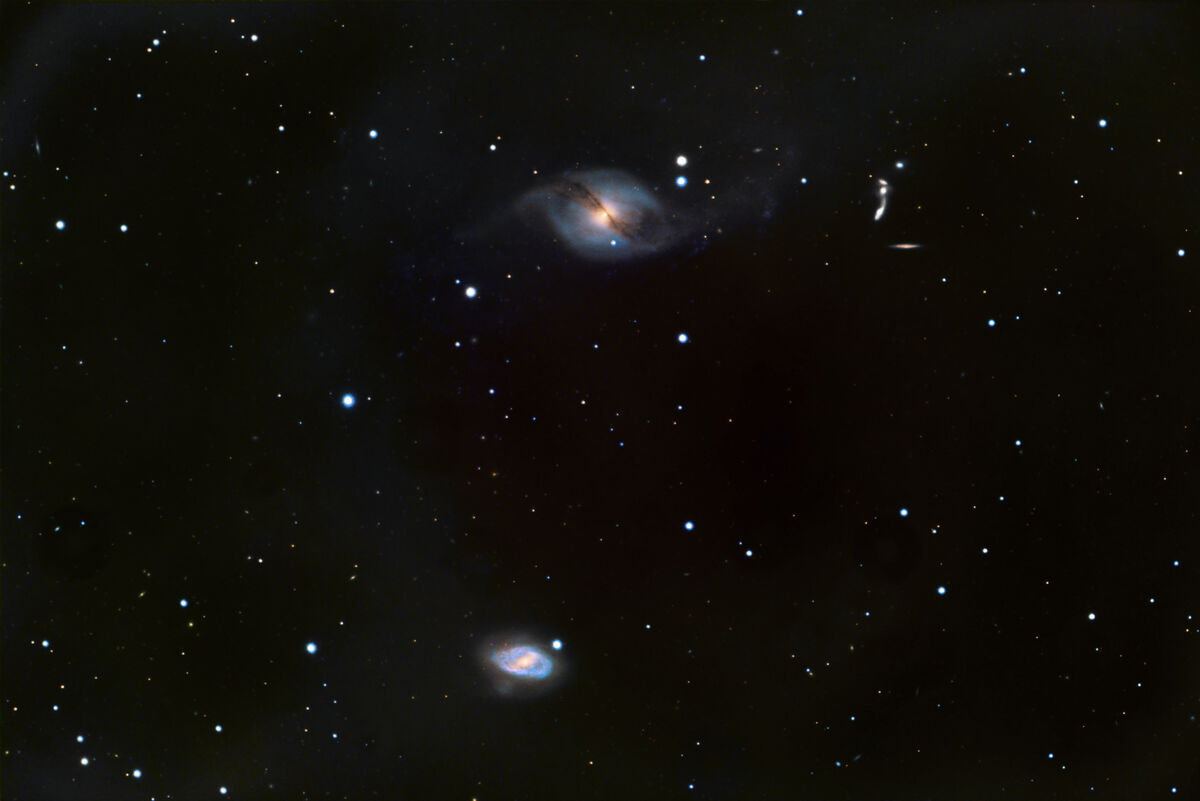NGC 3718
Jun 6, 2023 02:03:44 #
Ballard
Loc: Grass Valley, California
The image below is of a galaxy listed in the New General Catalogue as 3718 (or NGC 3718). This galaxy is ~52 million light years away in the constellation of Ursa Major. The strange warp in its shape is believed to be due to gravitational interaction between it and the smaller galaxy known as NGC 3729 that can be seen below it in this photo. NGC 3729 is around 150 thousand light years away from NGC 3718. On close inspection you can find a large number of much more distance galaxies in the image. The small group of 5 interacting galaxies just to the right of NGC 3718 is called Hickson Group 56 and over 400 million light years away.
This image was taken starting on 4/26/2023 though 5/24/2023. The long interval was due to the nasty weather we have been having lately and I only was able to get a few nights of somewhat OK imaging. I may try for this one next year if the seeing is better and I can get more integration time to remove some of the graininess in the image.
All questions, comments and suggestions are welcome.
For those interested this image was taken with a Meade LX 200 16 inch Schmidt Cassegrain with a focal length of 4064mm using an ASI 6200MM pro monochrome camera with 1x1 binning, the gain set to 100 and the temperature set to -12C
Luminance Channel 56 exposures at 3 minutes each
Red Channel 12 exposures at 4 minutes each and another 15 exposures at 5 minutes each
Green Channel 17 exposures at 5 minutes each
Blue 20 Channel 13 exposures at 5 minutes each
Total exposure time 7 hours 21 minutes.
The different number of exposures is mainly due to how many I had to throughout due to clouds and sky turbulence.
This image was taken starting on 4/26/2023 though 5/24/2023. The long interval was due to the nasty weather we have been having lately and I only was able to get a few nights of somewhat OK imaging. I may try for this one next year if the seeing is better and I can get more integration time to remove some of the graininess in the image.
All questions, comments and suggestions are welcome.
For those interested this image was taken with a Meade LX 200 16 inch Schmidt Cassegrain with a focal length of 4064mm using an ASI 6200MM pro monochrome camera with 1x1 binning, the gain set to 100 and the temperature set to -12C
Luminance Channel 56 exposures at 3 minutes each
Red Channel 12 exposures at 4 minutes each and another 15 exposures at 5 minutes each
Green Channel 17 exposures at 5 minutes each
Blue 20 Channel 13 exposures at 5 minutes each
Total exposure time 7 hours 21 minutes.
The different number of exposures is mainly due to how many I had to throughout due to clouds and sky turbulence.
Jun 6, 2023 05:31:25 #
Ballard wrote:
The image below is of a galaxy listed in the New G... (show quote)
My first thought was NCC-1701.

On the noise made by heated sensors, would a clear winter night be the best time to make such images?
Jun 6, 2023 05:36:07 #
Ballard wrote:
The image below is of a galaxy listed in the New G... (show quote)
It is amazing that the clarity of your images are so good, considering the fast distance and the atmosphere of earth that the Light has to go through. Thank you for sharing this. It’s very nice I like it.
Bruce
Jun 6, 2023 06:12:39 #
Ballard wrote:
The image below is of a galaxy listed in the New G... (show quote)
Amazing and incredible!
Jun 6, 2023 06:28:34 #
Interesting shapes to the two galaxies. Thanks for sharing.
Ballard wrote:
The image below is of a galaxy listed in the New G... (show quote)
Jun 6, 2023 06:33:11 #
Jun 6, 2023 07:11:40 #
Jun 6, 2023 07:16:24 #
Jun 6, 2023 07:29:46 #
Ballard wrote:
The image below is of a galaxy listed in the New G... (show quote)
All I can say is Wow!
Jun 6, 2023 07:40:59 #
Jun 6, 2023 07:49:17 #
Wow! Such professional dedication and understanding of both photography and astro-science! Photo-proof of entire galaxies inter-acting with each other. Photos and explanations like this make me feel so small in such a huge, awesome universe...
Jun 6, 2023 07:58:30 #
Jun 6, 2023 08:34:26 #
Jun 6, 2023 08:35:37 #
Jun 6, 2023 10:31:16 #
Ballard
Loc: Grass Valley, California
Wallen wrote:
My first thought was NCC-1701. 
On the noise made by heated sensors, would a clear winter night be the best time to make such images?

On the noise made by heated sensors, would a clear winter night be the best time to make such images?
Hi Wallen
Thanks for checking out the image of NGC 3718 and for the comment and smile. I also like star trek.
The turbulence is mainly due to upper atmospheric turbulence, particularly when different temperatures are mixing (kind of like looking over a road on a hot day). This happens a when we have a low moving into a high pressure zone and a jet stream is going gang busters (it has been doing a lot this spring). Although the winter can be clear it is very often turbulent and at a long focal length it causes a lot of blurring. For astrophotography I want nights where the stars are not twinkling much as this is a sign of good seeing.
If you want to reply, then register here. Registration is free and your account is created instantly, so you can post right away.












